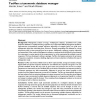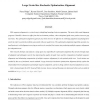BMCBI
2006
14 years 15 days ago
2006
Background: Several entropy-based methods have been developed for scoring sequence conservation in protein multiple sequence alignments. High scoring amino acid positions may corr...
BMCBI
2006
14 years 15 days ago
2006
Background: Phylogenetic analysis of large, multiple-gene datasets, assembled from public sequence databases, is rapidly becoming a popular way to approach difficult phylogenetic ...
BMCBI
2006
14 years 15 days ago
2006
Background: The majority of peptide bonds in proteins are found to occur in the trans conformation. However, for proline residues, a considerable fraction of Prolyl peptide bonds ...
BMCBI
2006
14 years 15 days ago
2006
Background: With the ever-increasing number of gene sequences in the public databases, generating and analyzing multiple sequence alignments becomes increasingly time consuming. N...
BMCBI
2008
14 years 17 days ago
2008
Background: With advances in DNA re-sequencing methods and Next-Generation parallel sequencing approaches, there has been a large increase in genomic efforts to define and analyze...
GECCO
2008
Springer
14 years 1 months ago
2008
Springer
This paper introduces GLOCSA as a new scoring function to rate multiple sequence alignments. It is intended to be simple, considering the whole alignment at once and reflecting t...
EVOW
2010
Springer
14 years 3 months ago
2010
Springer
A challenging problem in bioinformatics is the detection of residues that account for protein function specificity, not only in order to gain deeper insight in the nature of functi...
BIBE
2006
IEEE
14 years 6 months ago
2006
IEEE
DNA sequence alignment is a critical step in identifying homology between organisms. The most widely used alignment program, ClustalW, is known to suffer from the local minima pro...
RECOMB
2003
Springer
15 years 22 days ago
2003
Springer
We describe a novel method for detecting the domain structure of a protein from sequence information alone. The method is based on analyzing multiple sequence alignments that are ...
DCC
2009
IEEE
15 years 1 months ago
2009
IEEE
Rapid development of DNA sequencing technologies exponentially increases the amount of publicly available genomic data. Whole genome multiple sequence alignments represent a parti...


